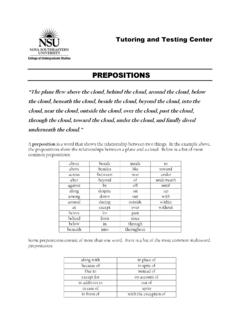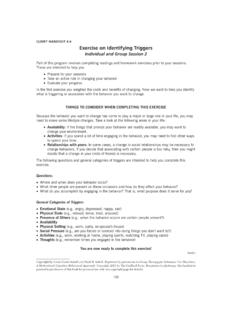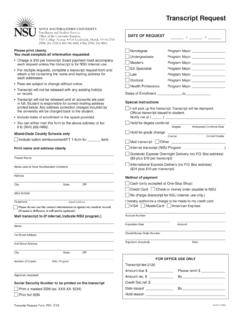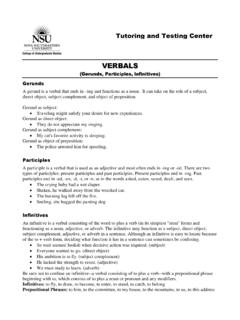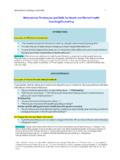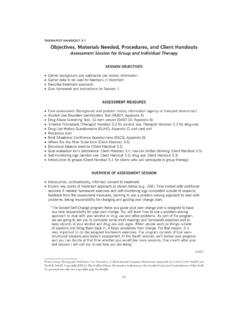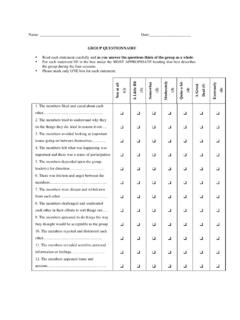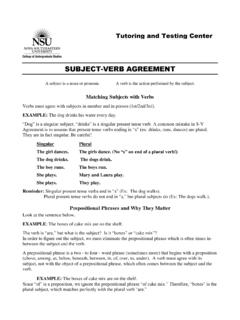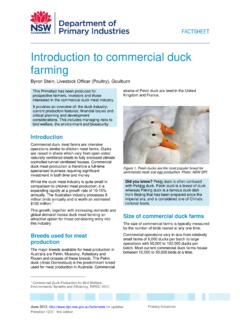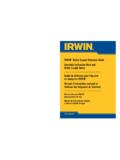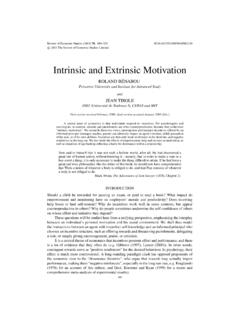Transcription of P. A. C. E. R. - Nova Southeastern University
1 P. A. C. E. R. Progressive Aerobic Cardiovascular Endurance Run Manual 2 About the PACER The Progressive Aerobic Cardiovascular Endurance Run (PACER) is a multistage shuttle run created by Leger and Lambert in PACER is designed to measure aerobic capacity, which is characterized by endurance, performance, and fitness. The objective of the PACER is to run as long as possible while keeping a specified pace. Students run back and forth across a 20-meter space at a pace that gets faster each minute. A point is scored for each 20-meter distance covered. The test is easier in the beginning but progressively gets more difficult. In comparison to distance running, the PACER is a more effective, fun, and easy way to measure aerobic capacity that encourages participation from all youth and is relatively easy to score and administer. 3 Table of Contents THE BASICS.
2 4 PROCEDURE .. 5 SAMPLE SCRIPT .. 8 SCORING .. 9 SAMPLE SCORE SHEETS .. 10 HEALTH NORMS RANGES .. 11 DEVELOPMENTAL CONSIDERATIONS .. 12 FREQUENTLY ASKED QUESTIONS .. 14 APPENDICES .. 17 4 The Basics What will I need? 20 meters of open space CD player Marker cones and/or tape Copies of the score sheet Measuring tape Pen/pencil PACER CD A designated cool-down area with water Setup: Use tape or cones to mark two parallel lines, 20 meters apart. Divide students into small groups or pairs It s a good idea to practice the PACER 1 or 2 times before the administration of the test. The students will feel more comfortable with the process, and there will be less confusion on test day! Quick Tip 5 Procedure Step 1: Make sure that the 20-meter course is marked with cones and tape and each of the lanes are divided. Step 2: Ensure that you have enough copies of either the group administration score sheets or the individual score sheets.
3 Step 3: Review the PACER instructions with the students. See sample script on page 6. Step 4: Instruct the first group of students to stand at the START line. Step 5: Begin the CD and listen for the word START, this signifies that the test has begun and the students should be running. Walking is permitted as long as the student maintains the pace. Step 6: Students will run from the START line to the END line and touch the END line with their foot before the BEEP sounds on the CD. Step 7: At the sound of the BEEP the students must turn around and run back to the other end. If students reach the line before the beep sounds, they must wait at the line until they hear the beep and then run back to the other end. Step 8: When the TRIPLE BEEP sounds students should turn around and run to the other end whether they are at the line or not. The only difference between the BEEP and the TRIPLE BEEP is that the TRIPLE BEEP sounds at the end of each minute and also alerts students that the pace will increase.
4 Step 9: Students continue running back and forth from the START line to the END line until they have completed the PACER or they have had two misses. If the students fails to reach the line by the time the BEEP sounds then that is counted as a miss. If a student has achieved two misses then they have completed the PACER and should go to the cool-down area. Please refer to page 7 for scoring instructions. Step 10: Thank and praise the students for their participation and then instruct the students to continue to walk and stretch in the designated cool-down area after they finish. 6 Procedure (cont.) When to Stop the PACER The first time a student does not reach the line by the BEEP, the student stops where he or she is and reverses direction, heading back toward the opposite line .The second time he or she fails to reach the line by the BEEP, the test is complete. After two times where the individual fails to reach the line by the beep the test is complete.
5 The two failed attempts to reach the line do not need to be consecutive. If a student remains at one end through TWO BEEPS the test is complete and the student goes to the cool-down area. Scenario Two: Scenario One: 7 Procedure (cont.) Important points to cover when providing instructions for the PACER: Remind students that the PACER is not a race. Inform students that they should turn around immediately after they hear a beep whether it is a triple beep or a single beep. Make sure that students understand the difference between a triple beep and a single beep. o Triple beep means that the speed is going to increase Remind students that if they reach the line before the beep then they should wait behind the line until they hear the beep. Be sure to remind students that if they do not reach the line before the beep sounds the second time that they should go towards the cool-down area. It will be helpful to play the cd for students so they are familiar with the instructions and the tones.
6 Refer to the sample script on page 8 for an example of how to incorporate these points, when you are instructing your students on the PACER. 8 Sample Instructions Script Hello Students! Today we are going to do some running; this is not a race. We want to see how long you can run: First: At the sound of the beep, you will run to the other end of this distance. Make sure when you get to the other end, you stand behind the line. o Ask the students What do you do at the sound of the beep? Then when you hear the beep again, I want you to run back to the opposite side and wait behind that other line. o Ask the students What do you do at the sound of the beep? (PLAY THE CD FOR THE STUDENTS TO LISTEN TO, NOTING THE TRIPLE BEEP.) Did everyone hear the triple beep? That means the pace will get faster and you will have to run faster to get to the other side before the beep sounds again. o Ask the students What do you do when you hear the triple beep?
7 O Ask the students, What does the triple beep mean? Two things to remember: 1) First, if you do not reach the line by the time the beep sounds, stop where you are, turn around and run back to the opposite line. This gives you a chance to try to get back on pace. 2) But, if you do not reach the line by the time the beep sounds a second time, you re done! You should walk to the cool down area and get some water. o Ask the students What do you if you don t make it to the line before the beep one time? o Ask the students What do you do if you if you don t make it to the line before the beep two times? 9 Scoring Remember: One lap is one 20-meter distance Scoring for Individual Administration The scorer crosses off the lap number on the PACER score sheet that the student has completed. If the student fails to reach the line before the beep, the scorer places a circle around the lap number. This counts as one miss . If the child fails to reach the line before the beep the second time, another circle is place around the lap number that was not completed.
8 This will be counted as the second miss . After two misses the child has completed the test. DO NOT continue to score after the child has two misses. The number of completed laps is the student s score on the PACER. The total score will be the number of laps completed before the second miss . See figure for an example Scoring for Group Administration There should be a ratio of no more than 2-3 children per scorer. o If the children are older, you can have them pair up and score each other. If there are multiple score keepers, they should stand in the middle of the area where the PACER is being conducted, so that they will be able to see when the student crosses the line. Each scorekeeper should score the two or three children that are the closest to them so that they will be able to see when each child crosses the line. If one student fails to reach the line before the beep, the scorer places a mark such as a star, next to the student s name.
9 This counts as one miss . The second time the child fails to reach the line before the beep, the last completed lap is recorded. For example fails to reach the line on lap 3, lap 2 is recorded on the score sheet See Figure for an example. Continue to mark the laps for each remaining student until they have achieved two misses . DO NOT continue to score after the child has failed to reach the line before the beep twice ( , if the child has two misses.) 10 Sample Score Sheets Figure Individual Score Sheet Min Laps 1 1 2 3 4 5 6 7 2 8 9 10 11 12 13 14 15 3 16 17 18 19 20 21 22 23 4 24 25 26 27 28 29 30 31 32 5 33 34 35 36 37 38 39 40 41 Figure Group Score Sheet Min Laps 1 1 2 3 4 5 6 7 2 8 9 10 11 12 13 14 15 3 16 17 18 19 20 21 22 23 4 24 25 26 27 28 29 30 31 32 5 33 34 35 36 37 38 39 40 41 Lane Student name Laps completed 1 *Sandy Lewis 14 2 *Michael Gonzales * Means that the student missed a lap Lane Student name Laps completed 1 Jessica Karle 7 Sandy missed the beep at lap 6 and lap 15.
10 So the number of laps completed is 14. Michael missed the beep at lap 10, but he is not done with the PACER because he only had one miss. The circles mean that the student did not make it to the line before the beep. The lines signify that the laps were completed. 11 What do the PACER scores mean? The scores on the following graph represent the health norms for individuals aged 10-17, organized by gender, based on the number of laps completed in a 20 meter PACER. The Low End Score represents the minimal level of fitness that could provide health benefits, if maintained into adulthood. The High End Score is the point where an increase in fitness no longer contributes significantly to further health benefits.. Health Norm Ranges for the PACER for ages 10-17+ Age Boys Girls Low end High end Low end High end 10 23 61 7 41 11 23 72 15 41 12 32 72 15 41 13 41 83 23 51 14 41 83 23 51 15 51 94 32 51 16 61 94 32 61 17 61 106 41 61 17+ 72 106 41 72 12 Developmental Considerations The PACER setup will be the same for all ages, but there are some adjustments to consider in administration and scoring with younger children.
